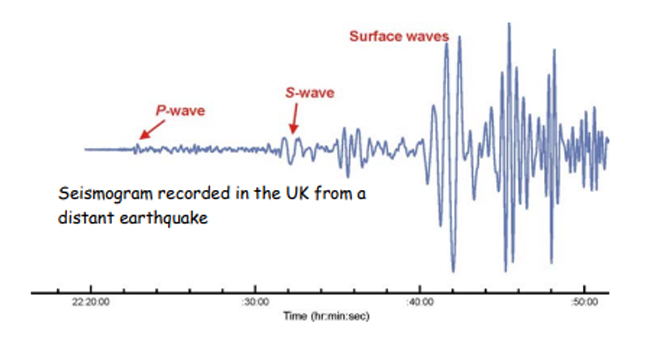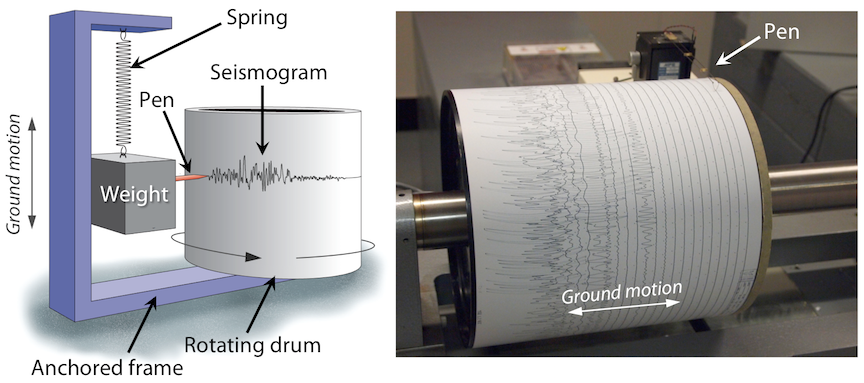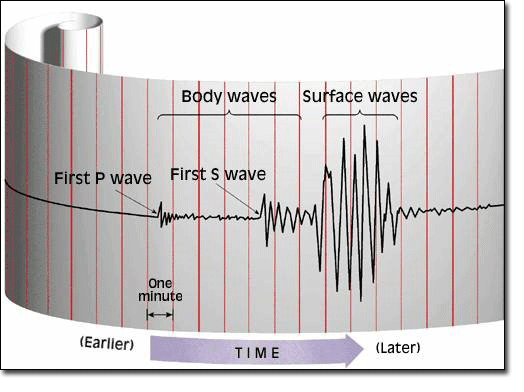However whereas both devices may detect and measure seismic waves only a seismograph possesses the capacity to record the phenomena. Seismic waves are propagating vibrations that carry energy from the source of an earthquake outward in all directions.

Measuring Earthquakes Seismograph Is An Instrument Used To Detect And Record Seismic Waves Ppt Download
The Mercalli scale rating for an earthquake b.

. Scientists can measure and record the seismic waves made by an earthquake using an instrument called a seismograph. Seismic waves travel at speeds of several kilometers per second. Geologists can use seismographs to detect hidden faults.
Generally we can say that it consists of a mass which is attached to a fixed base. A seismograph or seismometer is an instrument used to detect and record earthquakes. Seismograph instrument that makes a record of seismic waves caused by an earthquake explosion or other Earth-shaking phenomenon.
A seismograph is a device that can detect and record seismic waves - 18812242. Seismograms are the records paper copy or computer image used to calculate the location and magnitude of an earthquake. Seismic waves are propagating vibrations that carry energy from the source of an earthquake outward in all directions.
But sensitive detectors seismometers can record theses waves emitted by even the smallest earthquakes. The output of such a deviceformerly recorded on paper or film now recorded and processed digitallyis a seismogram. A record produced by a seismograph on a display screen or paper printout is called a seismogram.
In a seismometer the fixed object consists of a mass suspended on springs within a case. A seismograph or seismometer is known as an instrument which is used to record and detect earthquakes. A seismograph or seismometer is an instrument used to detect and record seismic waves.
They travel through the interior of the Earth and can be measured with sensitive detectors called seismographs. Long period seismographs respond to lower frequency waves and are used to record distant events. A seismograph is a simple pendulum.
When an earthquake happens energy shockwaves known as seismic waves are released from the earthquakes focal point. The terms seismograph and seismometer are often used interchangeably. They shake the Earth and transform soft deposits like clay into jelly for a short time liquefaction.
The motion of the base with respect to the mass is commonly transformed into an electrical. In a seismometer the fixed object consists of a mass suspended on springs within a case. When seismic waves encounter a fault they are reflected off of the fault.
Now during an earthquake the base moves and the mass does not. Seismographs are used by seismologists to record how long seismic waves take to travel across different layers of the Earth. The location of the epicenter 2 See answers Advertisement Advertisement l8ver l8ver.
Scientists have seismographs set up all over the. SeismogramA real-time record of earthquake ground motion recorded by a seismograph. What does a seismograph record.
They are usually combined with a timing device and a recording device to form a seismograph. A seismograph or seismometer is an instrument used to detect and record seismic waves. The motion of the base which is with respect to the mass is commonly said to be transformed into an.
During an earthquake the base moves and the mass does not. What does a seismograph record. Seismographs are the instruments which record earthquakes.
To rate the earthquake the seismograph will take three factors into consideration. How does a seismograph detect and record seismic waves. During an earthquake the mass remains still while the case around it moves with the ground shaking.
How does a seismograph detect and record seismic waves. Correspondingly how does a seismograph detect and record earthquakes. The word seismograph is.
Such data is used to. Generally it consists of a mass attached to a fixed base. Seismic waves lose much of their energy in traveling over great distances.
They are very sensitive instruments that can detect measure and record ground vibrations and their intensities during an earthquake. Seismographs are equipped with electromagnetic sensors that translate ground motions into electrical changes which are processed and recorded by the instruments analog or digital circuits. A seismometer is an instrument that responds to ground noises and shaking such as caused by earthquakes volcanic eruptions and explosions.
In order to record seismic waves scientists use a seismograph which rates earthquakes on a scale of 1-10. Scientists use these instruments as their principal tool to study seismic waves. The speed of seismic waves c.
When these detectors are connected to a system that produces a permanent recording they are. Long period seismographs respond to lower frequency waves and are used to record distant events. The ground movements caused by seismic waves d.
During an earthquake the mass remains still while the case around it moves with the ground shaking. What can a seismograph tell us. They travel through the interior of the Earth and can be measured with sensitive detectors called.
Earthquakes Booklet How We Measure Them

Leq How Are Seismic Waves Used To Determine The Distance From A Seismic Recording Station To The Epicenter Of An Earthquake Key Terms Seismograph Ppt Download

How Are Earthquakes Detected British Geological Survey

A Schematic Showing Propagation Of Seismic Waves And Recording Of The Download Scientific Diagram





0 Comments